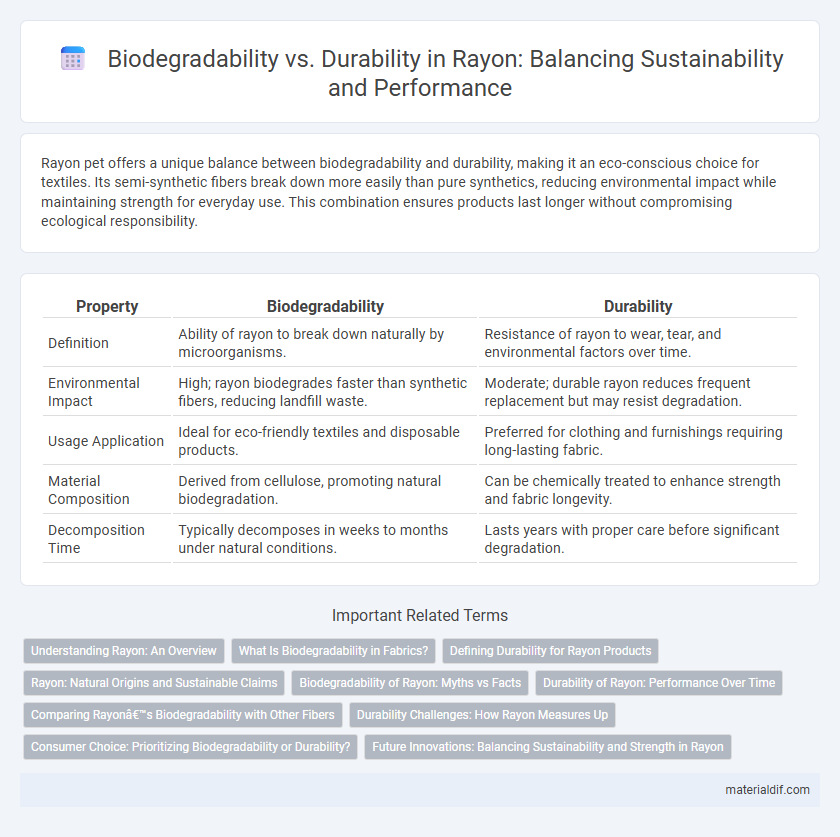Rayon pet offers a unique balance between biodegradability and durability, making it an eco-conscious choice for textiles. Its semi-synthetic fibers break down more easily than pure synthetics, reducing environmental impact while maintaining strength for everyday use. This combination ensures products last longer without compromising ecological responsibility.
Table of Comparison
| Property | Biodegradability | Durability |
|---|---|---|
| Definition | Ability of rayon to break down naturally by microorganisms. | Resistance of rayon to wear, tear, and environmental factors over time. |
| Environmental Impact | High; rayon biodegrades faster than synthetic fibers, reducing landfill waste. | Moderate; durable rayon reduces frequent replacement but may resist degradation. |
| Usage Application | Ideal for eco-friendly textiles and disposable products. | Preferred for clothing and furnishings requiring long-lasting fabric. |
| Material Composition | Derived from cellulose, promoting natural biodegradation. | Can be chemically treated to enhance strength and fabric longevity. |
| Decomposition Time | Typically decomposes in weeks to months under natural conditions. | Lasts years with proper care before significant degradation. |
Understanding Rayon: An Overview
Rayon is a semi-synthetic fiber derived from natural cellulose, offering a unique balance of biodegradability and durability. Unlike purely synthetic fibers, rayon decomposes more readily in natural environments, making it an eco-friendlier option for sustainable textiles. Its durability varies with fiber type and treatment but generally provides sufficient strength for diverse applications while maintaining environmental benefits.
What Is Biodegradability in Fabrics?
Biodegradability in fabrics refers to the ability of textile materials like rayon to naturally decompose through the action of microorganisms, reducing environmental impact. Rayon, derived from cellulose fibers, exhibits higher biodegradability compared to synthetic fibers such as polyester, making it a more eco-friendly option. Its balance of biodegradability and durability allows for sustainable use in fashion and textiles without compromising fabric performance.
Defining Durability for Rayon Products
Durability for rayon products refers to the fabric's ability to maintain strength, appearance, and functionality despite repeated use and washing. While rayon offers excellent softness and breathability, its durability can vary based on fiber length and fabric construction, impacting the lifespan of finished products. Balancing biodegradability with sufficient durability is crucial for sustainable textile applications, ensuring rayon items perform well while reducing environmental impact.
Rayon: Natural Origins and Sustainable Claims
Rayon, derived from natural cellulose fibers such as wood pulp, offers a biodegradable alternative to synthetic textiles while maintaining considerable durability in various applications. Its semi-synthetic nature allows it to decompose more readily under environmental conditions compared to pure synthetic fibers like polyester, supporting sustainable practices in textile production. However, the biodegradability of rayon can be influenced by chemical treatments and finishes applied during manufacturing, which may affect its overall environmental impact.
Biodegradability of Rayon: Myths vs Facts
Rayon, often mistaken for synthetic fibers, is a semi-synthetic fiber derived from natural cellulose, making it biodegradable under the right environmental conditions. Unlike fully synthetic fibers like polyester, rayon decomposes more rapidly in soil and compost, challenging the myth that all man-made fibers persist indefinitely. Its biodegradability contributes to lower environmental impact, but durability varies with manufacturing processes affecting fiber structure and lifespan.
Durability of Rayon: Performance Over Time
Rayon demonstrates moderate durability with a tendency to weaken when exposed to prolonged moisture and friction, impacting its long-term performance. Despite being less robust than synthetic fibers like polyester, rayon maintains sufficient strength for many applications when cared for properly, such as gentle washing and avoiding excessive stretching. Its durability makes it suitable for garments requiring softness and breathability, although repeated stress and exposure can reduce its lifespan compared to more resilient textiles.
Comparing Rayon’s Biodegradability with Other Fibers
Rayon exhibits superior biodegradability compared to synthetic fibers such as polyester and nylon, decomposing much faster under natural conditions due to its cellulose-based composition. In contrast to natural fibers like cotton and wool, rayon's biodegradation rate is comparable but influenced by manufacturing additives and chemical treatments. This balance of biodegradability and durability positions rayon as an eco-friendlier alternative in textile applications while maintaining sufficient strength for everyday use.
Durability Challenges: How Rayon Measures Up
Rayon faces durability challenges due to its lower resistance to abrasion and moisture compared to synthetic fibers, often resulting in weakened fiber strength after repeated washing. The cellulose-based structure of rayon makes it prone to shrinking and wrinkling, which compromises fabric stability and longevity. Despite these drawbacks, advancements in fiber treatment and blending techniques have enhanced rayon's durability, making it more competitive in textile applications requiring moderate wear resistance.
Consumer Choice: Prioritizing Biodegradability or Durability?
Consumers choosing rayon often weigh biodegradability against durability, as rayon offers natural fiber biodegradability but can lack the long-lasting strength of synthetic alternatives. Prioritizing biodegradability appeals to eco-conscious buyers seeking sustainable fabrics that decompose quickly in the environment, reducing landfill impact. Conversely, durability-focused consumers favor rayon blends treated for enhanced wear resistance, balancing environmental concerns with extended garment lifespan.
Future Innovations: Balancing Sustainability and Strength in Rayon
Future innovations in rayon aim to enhance biodegradability without compromising durability by developing advanced cellulose regeneration techniques and eco-friendly chemical processes. Researchers are exploring bio-based additives and nanocellulose reinforcement to improve fiber strength while maintaining rapid decomposition in natural environments. These breakthroughs promise a sustainable balance, making rayon a leading material in eco-conscious textile manufacturing.
Biodegradability vs Durability Infographic

 materialdif.com
materialdif.com